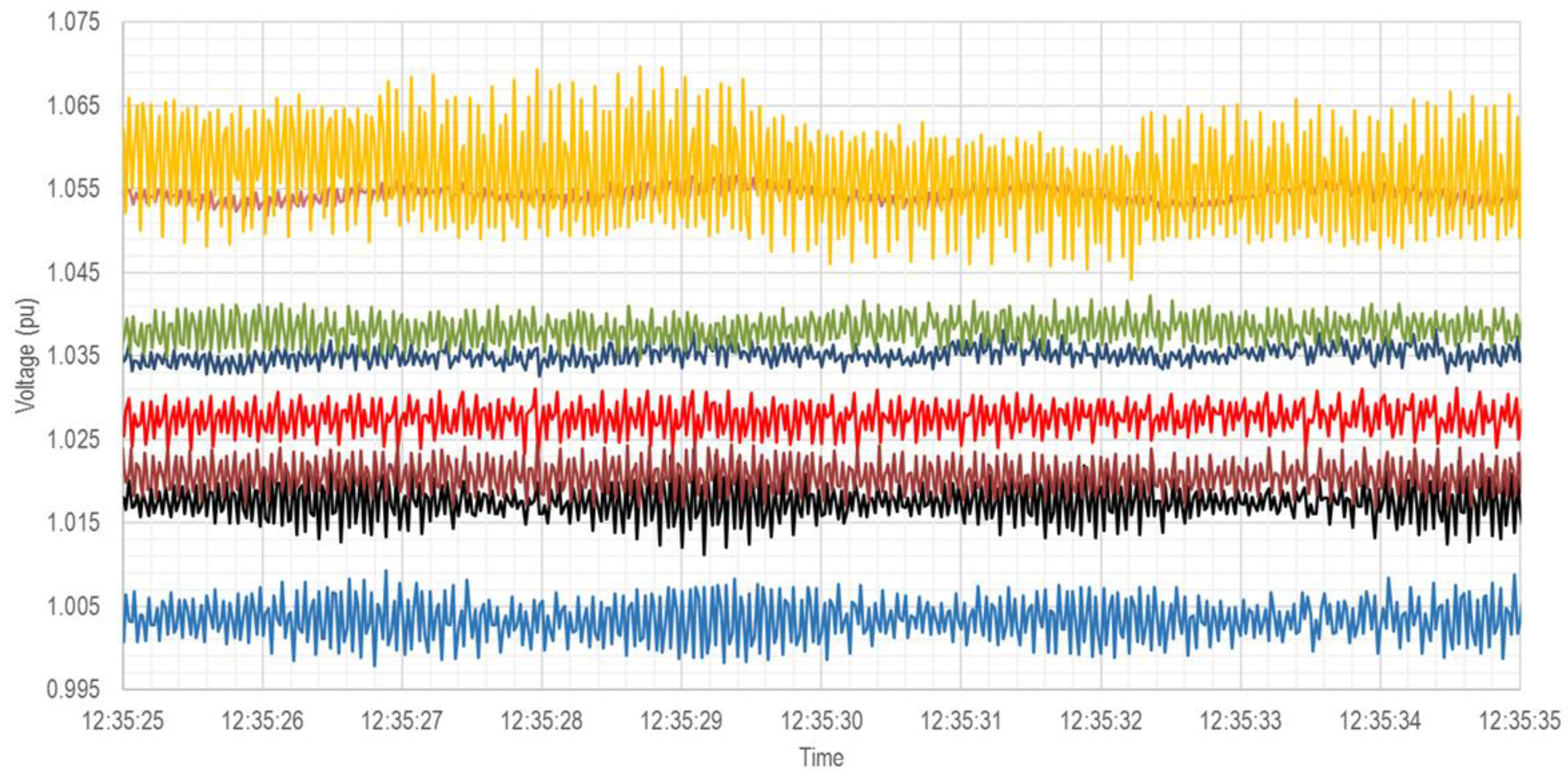There are things you know about, and things you don’t. The known and the unknown. And in between are the
doorsdata.
Overview of my research for non-specialists
We are at an inflection point of the energy transition to electrification and 100% renewable energy sources. This transition will place a significant burden on electric grids as we connect solar and wind power, which behave differently than traditional power plants, and as we increase the amount of electricity we use by transitioning to electric transportation and heating.
The energy transition bears significant technical risk—technical mishaps and/or inefficient allocation of resources shape public opinion and may jeopardize the transition to renewable energy. Electricity market deregulation serves as a cautionary tale; the mishandling of the California energy market deregulation in the late 1990s arrested energy market deregulation and we are still experiencing the effects. Unfortunately, the physics of climate change do not allow for the mishandling of the transition to renewable energy.
The standard engineering approach to controlling/optimizing a system (e.g. an airplane) is to build a model of the system based on physics, and then design controllers/algorithms based on that model so that the system behaves in a desirable manner (the airplane flies smoothly). However, this approach does not generally apply to electric grids because it is impossible to build and maintain a model of the entire electric grid based on physics — the system is too big and there are too many unknowns. Different engineering approaches are need to make the grid operate smoothly and in a cost-effective manner.
This is where my research comes in; I develop tools for controlling/optimizing the grid (specifically, the devices that attach to the grid) that rely on measurements of the grid, rather than requiring an accurate model of the grid. In general, these tools rely heavily on mathematical theory to guarantee that they will work in any given situation — because we rely on electric grids, we cannot have tools that just work most of the time. The tools that I have developed include tools for
controlling the inverters that connect solar, wind, and battery power to the grid,
interpreting the data from sensors to detect when something unexpected is happening on the grid, and
determining when and where electric vehicles should charge to avoid overloading the grid.
The high-level motivation for these tools is to make the integration of renewable energy resources cost-effective by resolving the issues that may arise as the electric grid evolves.
Research Overview
I develop new data-driven control and optimization tools and theory to facilitate the “electrification of everything” and the transition to 100% renewable energy electric grids.
The primary challenges facing power system researchers are to
- maintain grid stability, and
- minimize costs by maximizing transmission and storage value, without sacrificing reliability.
Traditionally, there has been a gap between industry and academic power systems research. This is, in part, because accurate power system models exist only in textbooks. Novel data-driven control and optimization techniques can bridge the gap between academia and industry to address challenges (1) and (2).
My postdoc research at ETH is focused on data-driven control for power systems. Specifically, I am developing online Data-Driven Predictive Control (oDDPC) for grid-connected inverters. oDDPC has involved developing new theory for data sets that are gathered in closed loop, as large grid-connected converters cannot be connected to the grid in open loop (i.e. without a well-tuned controller), and new behavioral systems theory for linear, time-varying systems.
My Ph.D. research at UC Berkeley focused on distribution network identification and optimization. This research included identifying networks from synchrophasor measurements, dynamic state estimation, Voltage Phasor Control, Feedback Optimization of EV charging, and new power flow linearization theory.
My future research will include mentoring students working on these research directions, with a particular focus on applying the tools we have developed on real power systems, closing the gap between academia and industry. In addition, I plan on developing new control and optimization theory that will change how we operate power systems, making electrification and 100% renewable energy a reality.
Inverter Control
Many renewable energy sources such as solar and wind power attach to the grid through inverters, which convert DC to AC power. Today, inverters are controlled to “follow” the grid, and do little to contribute to grid stability. In the future, if we want to power the electric grid with renewable energy sources, the inverters will have to actively contribute to grid stability.
Online, Data-Driven Inverter Control
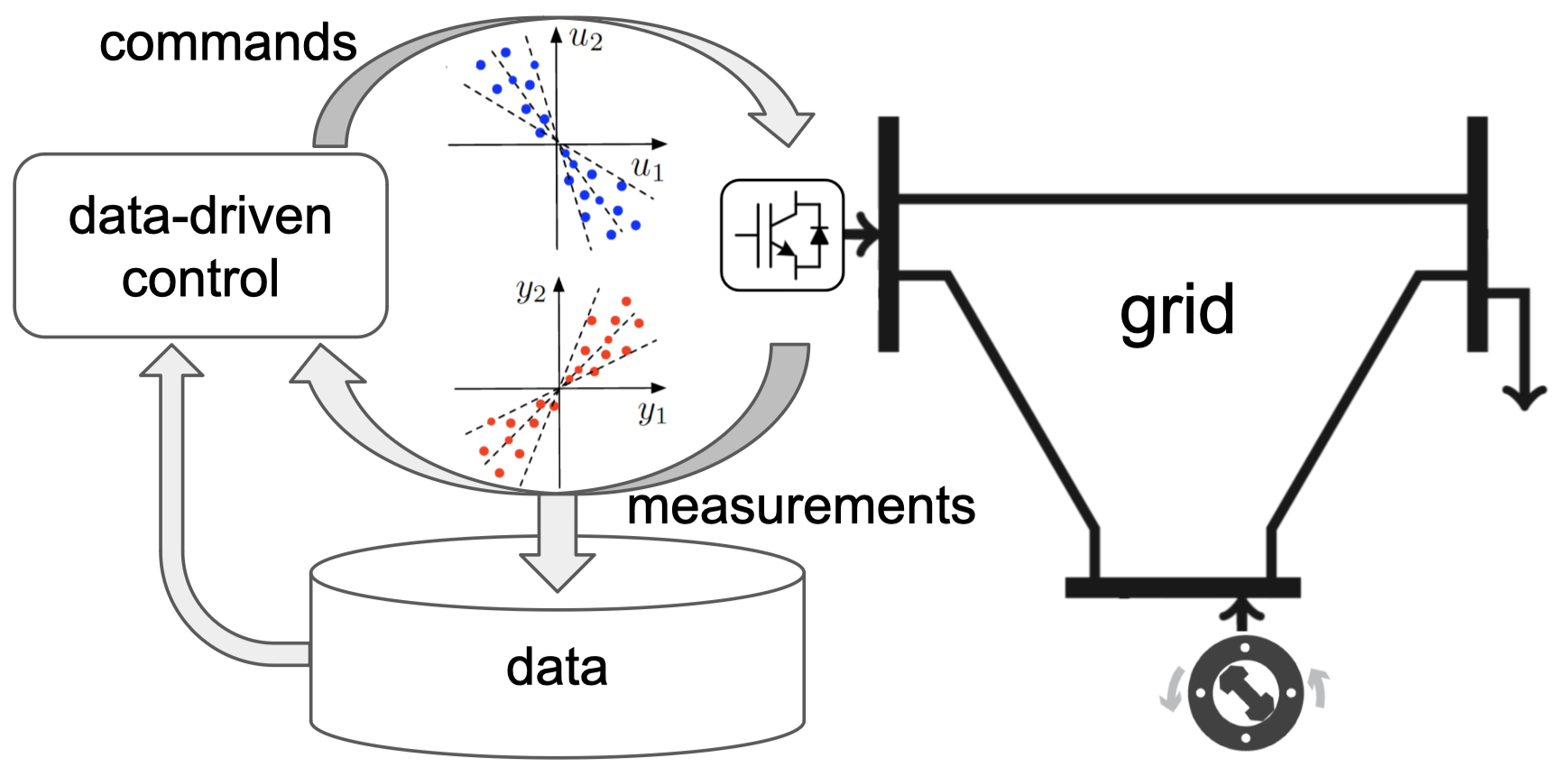 |
If designed correctly, Inverter Based Resources (IBRs) will help rather than exacerbate grid stability challenges. However, handling physical limitations (e.g. AC-side output current) of converter hardware remains an open question. Feasible Fast Frequency Response is challenging because grid dynamic models are generally not available. Data-Driven Predictive Control (DDPC) is well suited for Feasible Fast Frequency Response because it avoids constraints without requiring a model of the grid dynamics. Applying DDPC to converters requires innovation in both power system understanding (i.e. how should we design the cost function?), and in data-driven control theory. The data used to make control decisions must be gathered in closed loop with the grid, but closed-loop data introduces bias–that is, the data does not accurately represent the system that the DDPC is applied to. Thus, new ‘‘learning-while-doing’’ methods are required. I am currently working with Prof. Chiuso at University of Padova to develop a closed-loop DDPC method to deploy Feasible Fast Frequency Response on grid-connected IBRs. |
Quantifying Inverter Grid Contrbutions
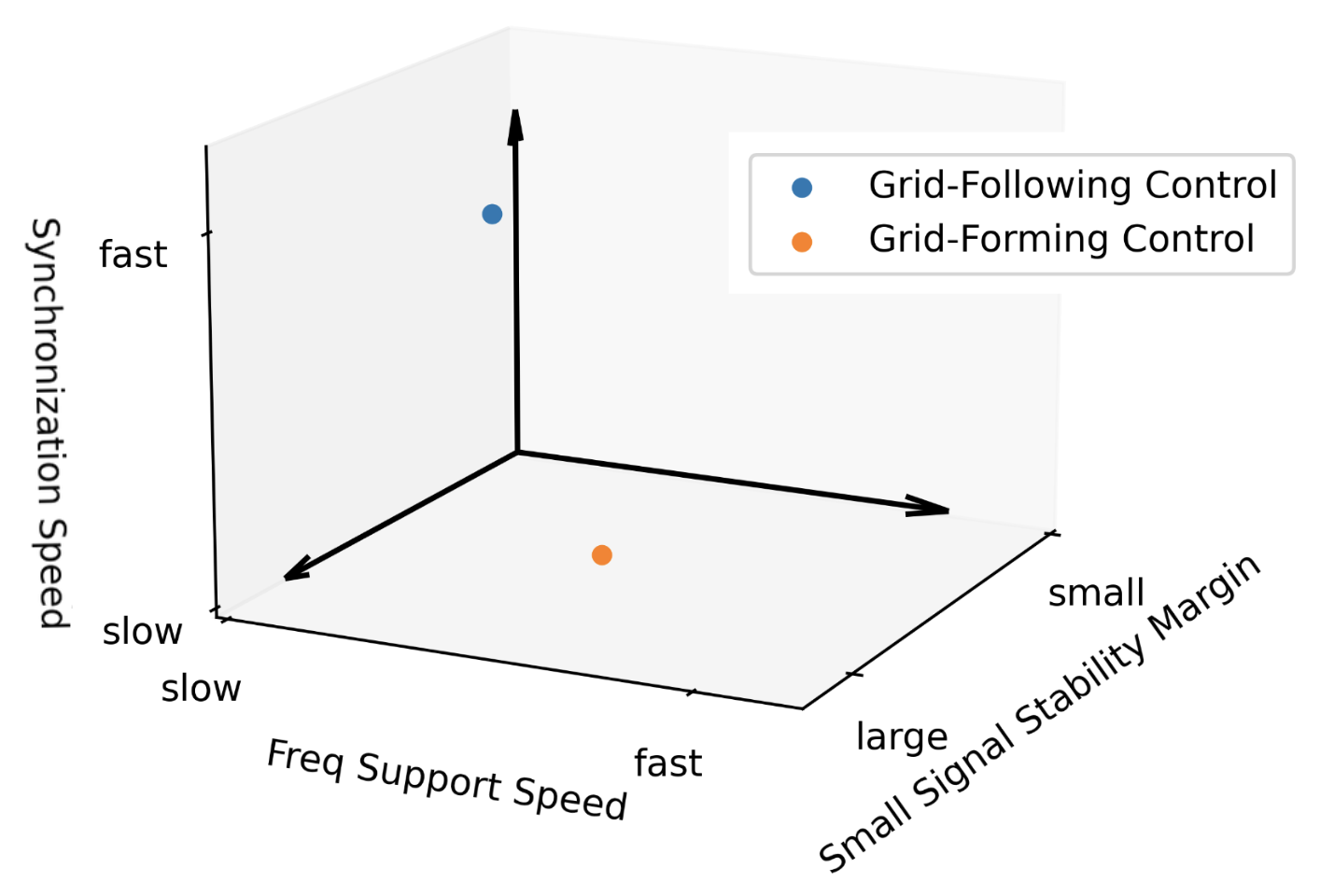 |
Stabilizing the future power grid will not be as simple as closing grid-following virtual inertia loops around IBRs. We must intelligently controlling IBRs, but first we must decide what ‘‘intelligently controlling IBRs’’ means. The first step in this direction is using quantitative, rather than qualitative, metrics to describe grid-connected inverter behavior. I am working on connecting quantitative open-loop inverter characteristics with closed-loop metrics that describe desirable behavior for grid-connected IBRs. Understanding this connection will allow the power systems community to determine the objectives for inverter control and codify inverter behavior in grid standards and, perhaps, ancillary service markets. |
Data-Driven System Monitoring and Estimation
Distribution network models are often inaccurate or not available to grid operators. Accurate, online estimation of the network parameters, the network topology, and/or the system state will allow distribution network operators to detect unexpected changes in the network (e.g. cyberattacks or equipment degradation), tune plug-and-play (e.g. volt-VAR and volt-Watt) regulators, and implement active management for congestion relief.
Grid Model Estimation
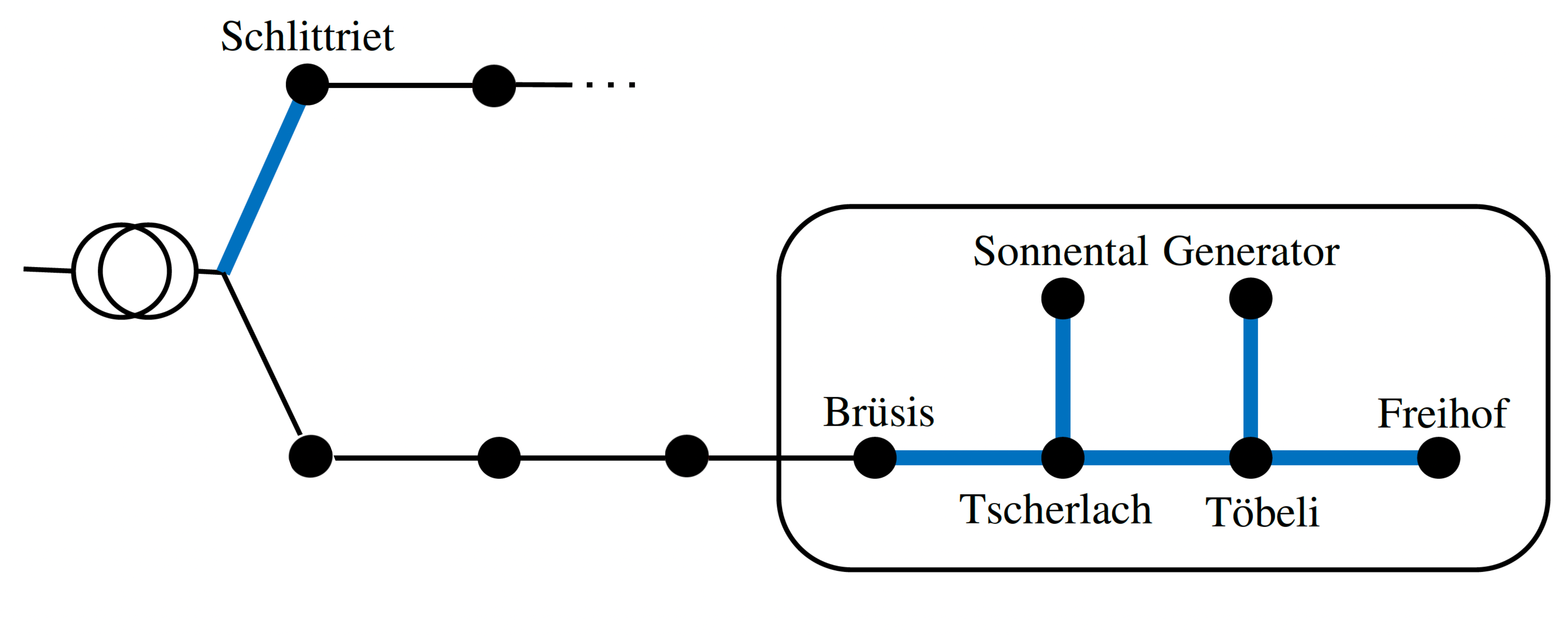 |
The vision for power system network parameter estimation is to learn the network’s admittance matrix from data. This turns out to be challenging, even when high-precision Phasor Measurement Units (PMUs) are available. Despite the challenges, the power systems research community has made steady progress over the past decade. This past year, we have successfully identified the admittance of a portion of the network in Walenstadt, Switzerland. In [Network Estimation, Limitation and Tools], we established a benchmark and a fundamental limit for estimating the network admittance from noisy synchrophasor voltage and current measurements. We proved that, while it is generally not possible accurately estimate the full network admittance matrix due to the rank-deficiency of the data, it is always possible to estimate the Kron-reduced network. We also provided methods for increasing noise-robustness and reconstructed radial tree graphs from complex-valued Kron-reduced graphs. Building upon this work, our [Distribution Grid ID] paper demonstrated the first accurate three-phase distribution grid estimation from simulated PMU measurements with realistic signal-to-noise ratios (Empirical paper) by using a Bayesian Error-In-Variables formulation. We have also investigated grid model estimation using smart meter data, rather than PMU data, which does not include phase angle measurements. Recently submitted work has demonstrated that, while admittance estimation is biased, network impedance can be estimated without bias from smart meter measurements. We validated these findings using real data from the town of Walenstadt, Switzerland, successfully identifying parameters of the Walenstadt grid from smart meter measurements (Smart Meter paper). |
Relevant publications:
K. Moffat, M. Bariya, and A. Von Meier. Unsupervised impedance and topology estimation of distribution networks—limitations and tools. IEEE Transactions on Smart Grid, 11(1):846–856, 2019. Paper link.
M. Bariya, K. Moffat, and A. Von Meier. Empirical noise estimation in distribution synchrophasor measurements. In 2019 International Conference on Smart Grid Synchronized Measurements and Analytics, pages 1–7. IEEE, 2019. Paper link.
J.-S. Brouillon, E. Fabbiani, P. Nahata, K. Moffat, F. Dorfler, and G. Ferrari-Trecate. Bayesian error-in-variables models for the identification of distribution grids. IEEE Transactions on Power Systems, In Revision, 2022. Paper link.
J.-S. Brouillon, K. Moffat, F. Dorfler, and G. Ferrari-Trecate. Power Grid Parameter Estimation Without Phase Measurements: Theory and Empirical Validation. In 2024 IEEE Power Systems Computation Conference (PSCC), Submitted, pages 1–9. IEEE, 2024. Working Paper Link.
Distribution Network State Estimation
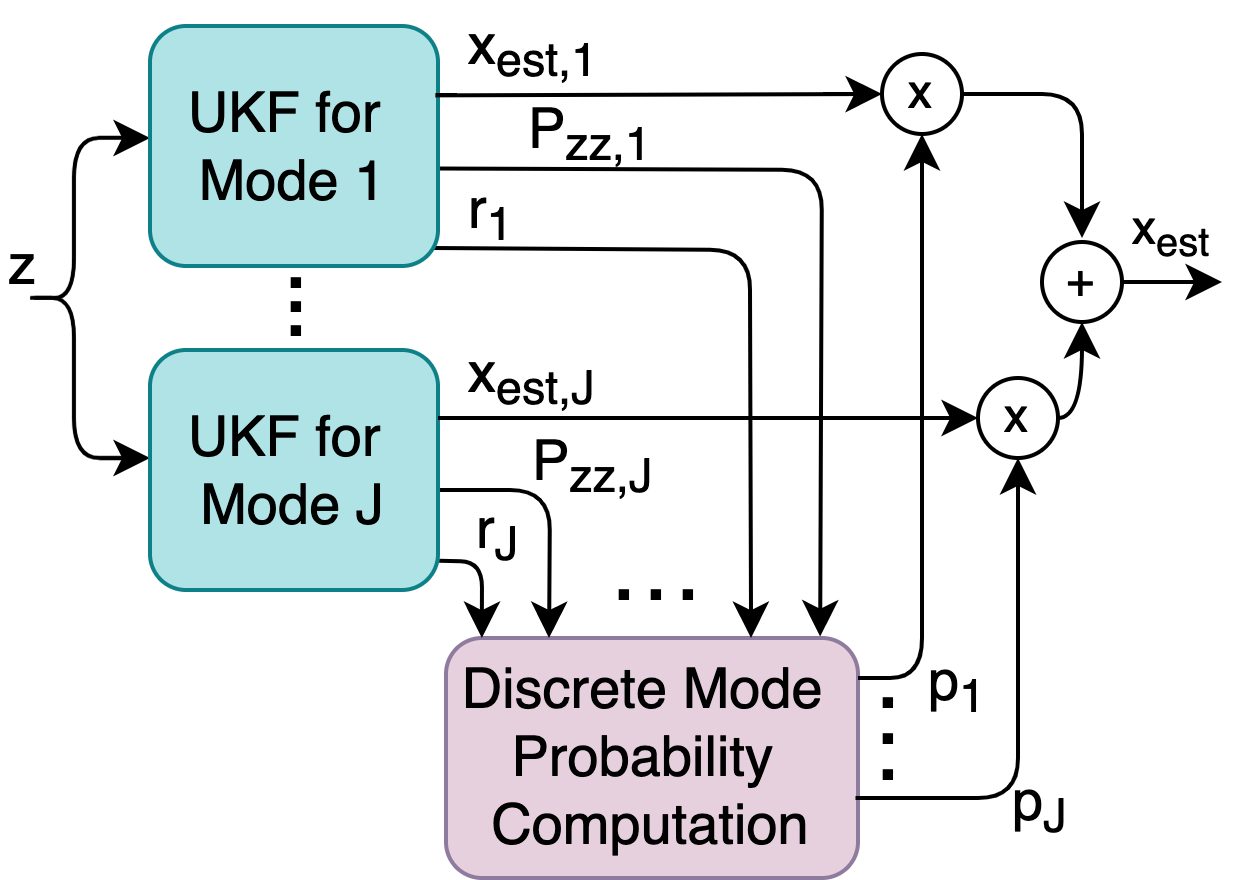 |
Traditional power system state estimation methods are static (not recursive) and assume that the network model is known, which is rarely the case for distribution networks. Distribution network State Estimation (DSE) is still in its nascent stages. The methods below, MAPSE and AIRLS, are novel ways of recursively estimating both the state and the network. Future research will connect DSE with emerging active distribution network management methods to demonstrate the value of DSE. When the network is not known but candidate network models and/or switch configurations are available, the [Multiple model Adaptive Power system State Estimator] (MAPSE) estimates the state and detects the most likely network model. MAPSE models the distribution network as a dynamic hybrid system and applies Bayesian recursion to a bank of Unscented Kalman Filters. The voltage phasors are the continuous state variables, and the candidate network models are the discrete variables. Future research directions include validating the method with real data from a distribution network with known topology changes. Alternatively, when the network is not known and candidate network models are not available, both the system state and the parameters must be estimated from input and output measurements. One option for this is applying the Alternating and Iteratively-reweighted Recursive Least Squares (AIRLS) algorithm, which estimates both the system parameters and the state recursively, and is robust to measurement outliers. |
Relevant publications:
K. Moffat and C. Tomlin. The multiple model adaptive power system state estimator. In 2021 IEEE Conference on Decision and Control (CDC), pages 1–6. IEEE, 2021. Paper link.
J. S. Brouillon, K. Moffat, F. Dörfler, & G. Ferrari-Trecate. Robust online joint state/input/parameter estimation of linear systems. In 2022 IEEE 61st Conference on Decision and Control (CDC) (pp. 2153-2158). IEEE. Paper link.
Active Distribution Networks
The transition to 100%-renewable energy generation requires more performance from the grid edge to minimize operating costs without sacrificing reliability. Distribution networks have traditionally been operated in a fit-and-forget manner in which new Distributed Energy Resources (DERs) such as electric vehicle charging stations, solar generation sites, and wind turbines can only be added after expensive interconnection capacity studies and grid upgrades. Actively managing DERs such as EV charging, energy storage, and distributed solar and wind generation can avert the potential crisis in which distribution capacity is insufficient and cannot be upgraded fast enough, paralyzing electrification.
Voltage Phasor Control
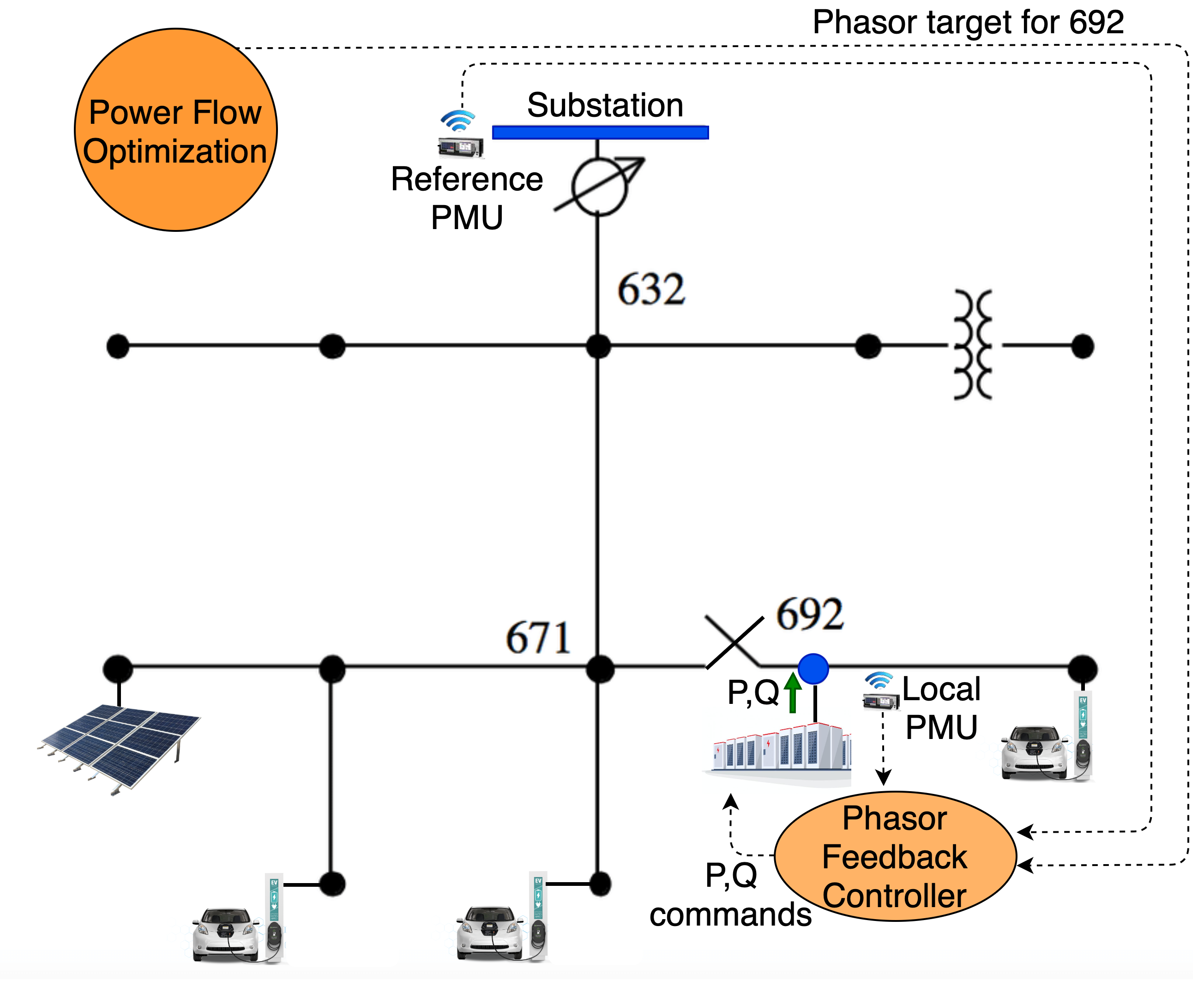 |
Voltage Phasor Control (VPC), introduced by Sascha von Meier at Berkeley [Intro paper], is a new way of controlling distributed energy resources in which a power flow optimization broadcasts voltage phasor targets to distributed feedback controllers, rather than open-loop power setpoints. We demonstrated VPC on unbalanced, three-phase distribution networks in Hardware-In-the-Loop simulations at Lawrence Berkeley Lab (LBL)'s FLEXLAB test site using the Distributed Extensible Grid Control (DEGC) software platform [DEGC paper] developed by our lab [VPC with DEGC paper] and adaptive MIMO feedback control [P-V Sensitivity presentation, MIMO Phasor Control presentation]. We have also proved that VPC is more effective than both open-loop power commands and voltage magnitude control in avoiding upstream line flow constraint violations, providing a clear use case for VPC and guidelines for how it should be applied in active distribution networks [VPC for ADNs]. |
Relevant publications:
K. Moffat and A. Von Meier. Using voltage phasor control to avoid distribution network constraint violations. Working Paper Link.
von Meier, A., Ratnam, E. L., Brady, K., K. Moffat., & Swartz, J. (2020). Phasor-based control for scalable integration of variable energy resources. Energies, 13(1), 190. Paper Link
K. Moffat and A. von Meier. Linear quadratic phasor control of unbalanced distribution networks. In 2021 IEEE Madrid PowerTech, pages 1–6. IEEE, 2021. Paper link, PowerTech 2021 presentation.
K. Moffat Local power-voltage sensitivity and thevenin impedance estimation from phasor measurements. In 2021 IEEE Madrid PowerTech, pages 1–6. IEEE, 2021. Paper link, PowerTech2021 presentation.
K. Moffat, J. Pakshong, L. Chu, G. Fierro, Baudette J., Swartz, J., and A. von Meier. Phasor based control with the distributed, extensible grid control platform. In 2021 IEEE Power & Energy Society Innovative Smart Grid Technologies Conference (ISGT), pages 1–5. IEEE, 2021. Paper link.
G. Fierro, K. Moffat, J. Pakshong, and A. von Meier. An extensible software and communication platform for distributed energy resource management. In 2020 IEEE International Conference on Communications, Control, and Computing Technologies for Smart Grids (SmartGridComm), pages 1–6. IEEE, 2020. Paper link.
Feedback Optimization for EV Charging
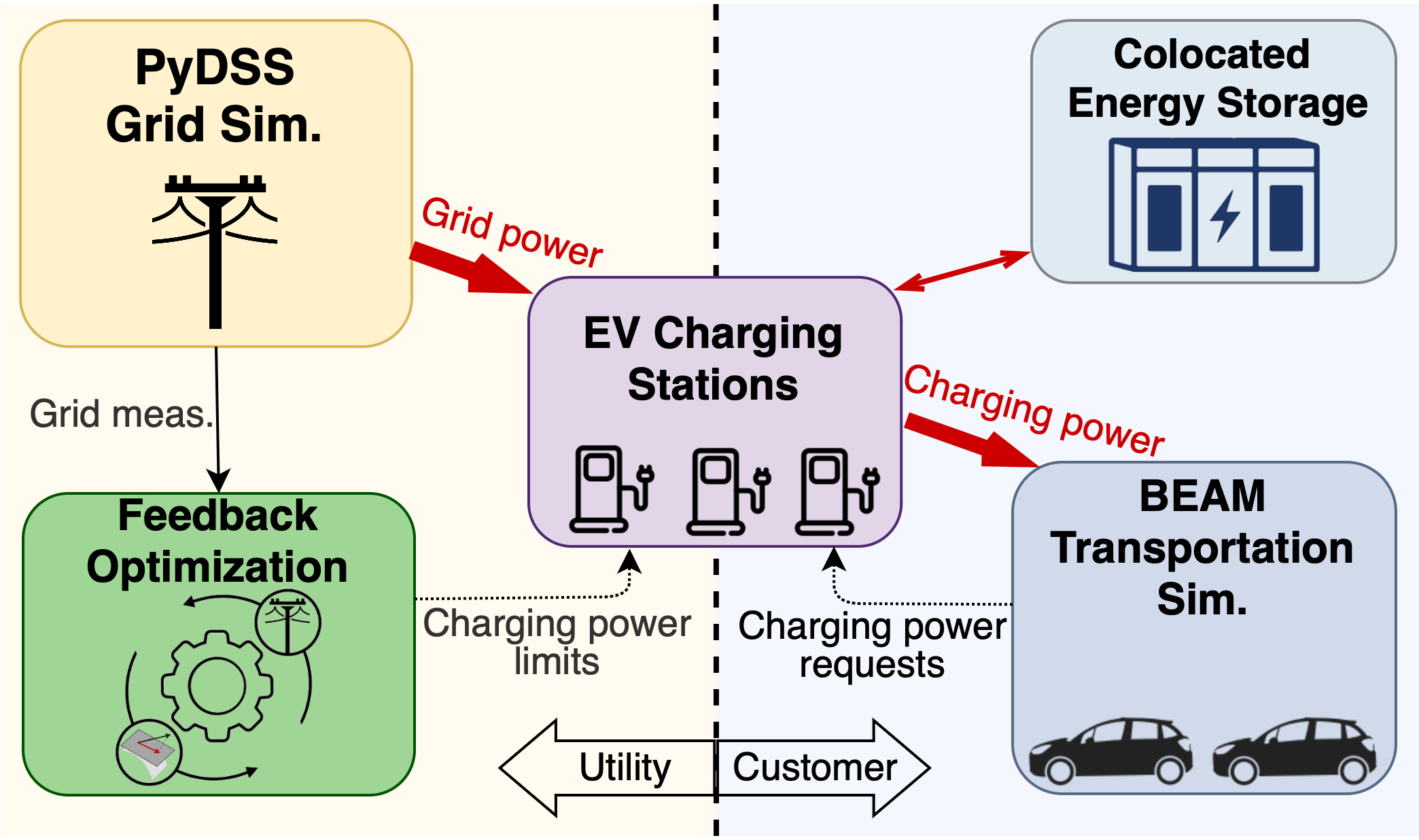 |
I worked with teams at the National Renewable Energy Lab (NREL) and (LBL) on the Department of Energy's GEMINI-XFC project to coordinate EV charging on oversubscribed distribution networks — that is, networks with lots of EV charging stations which must be actively managed to not overload distribution network infrastructure. We demonstrated the algorithms on a transportation network-and-distribution grid co-simulation of the Bay Area. The Feedback Optimization (FO) algorithm runs in closed loop with the physical network, using the physical system to ‘‘solve’’ power flow. That is, rather than solving the Optimal Power Flow problem to completion, FO takes one gradient step then actuates. The only model information required by FO is the sensitivity between the inputs — the electric vehicle charging power allocations — and the outputs — the voltage and lineflows at sensitive locations on the distribution network. Because FO optimizes in closed loop with the physical system, the algorithm is robust to model mismatch. Furthermore, because FO just takes one gradient step, it can be run on large-scale systems. |
N. Panossian, M. Muratori, B. Palmintier, A. Meintz, T. Lipman, & K. Moffat. (2022). Challenges and opportunities of integrating electric vehicles in electricity distribution systems. Current sustainable/renewable energy reports, 9(2), 27-40. Paper link.
N. Panossian, H. Laarabi, K. Moffat., H. Chang, B. Palmintier, A. Meintz, & R. A. Waraich (2023). Architecture for Co-Simulation of Transportation and Distribution Systems with Electric Vehicle Charging at Scale in the San Francisco Bay Area. Energies, 16(5), 2189. Paper link.
Future Research Directions
Data-Driven Power System Stability
Nonlinear Data-Driven Control
 |
Attention in the field of nonlinear data-driven control has been focused on (Deep) Reinforcement Learning (RL) for the past decade due to its impressive capabilities and demonstrations. These algorithms use large amounts of data and often require an accurate simulator. It is possible that alternative nonlinear data-driven control formulations are preferable in situations in which
Power systems satisfy all three of these criteria. New, nonlinear data-driven control methods are necessary to address the persistent, safety-critical power systems challenges such as controlling inverters during grid faults. |
Data-Driven Dispatch and Data-Driven Markets
 |
As stated above, the primary challenges facing power system researchers are 1) maintaining grid stability, and 2) minimizing operating costs without sacrificing reliability. (2) is primarily a resource-scheduling challenge.
Resource scheduling (Unit commitment/economic dispatch, demand response dispatch, and energy storage market bidding) decisions can be described as online, receding-horizon stochastic programming problems. The dispatch/market mechanisms used today are not designed to deal with the intermittent and stochastic nature of wind and solar power, and thus do not use grid resources in the most cost-effective manner or provide the correct market signals for installing new resources.
Similar to the grid-stability challenges discussed above, data may be the key to scheduling systems with intermittent and stochastic resources. Promising methods include
Model-Free Feedback Optimization,
Unsupervised Learning + Scenario Optimization, and
Online Distributionally Robust Optimization.
These methods are open fields of research and it is possible that at least one of them will provide a step-change in how we make scheduling decisions for grids with renewable resources.
Disclaimer: This material is presented to ensure timely dissemination of scholarly and technical work. Copyright and all rights therein are retained by authors or by other copyright holders. Each person copying this information is expected to adhere to the terms and constraints invoked by the copyright. In most cases, these works may not be reposted without the explicit permission of the copyright holder.
